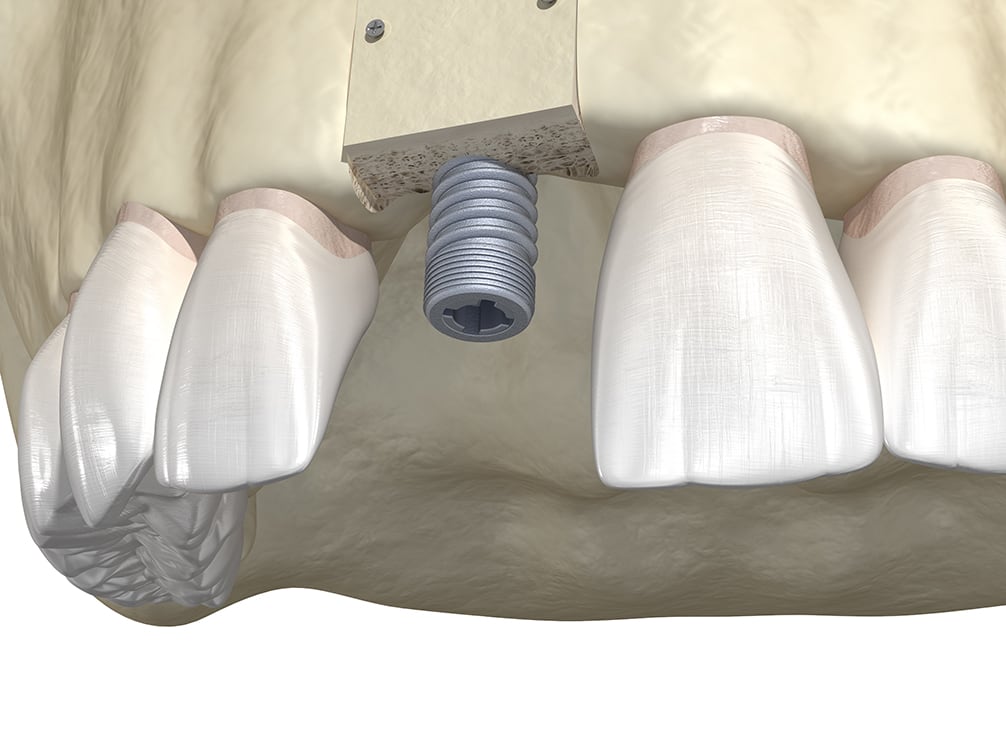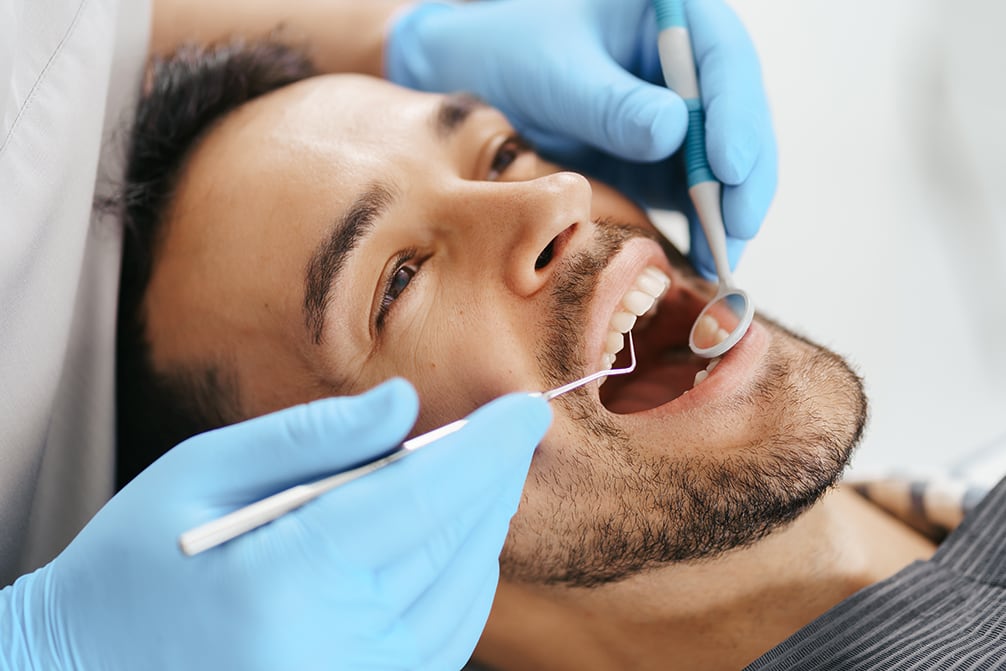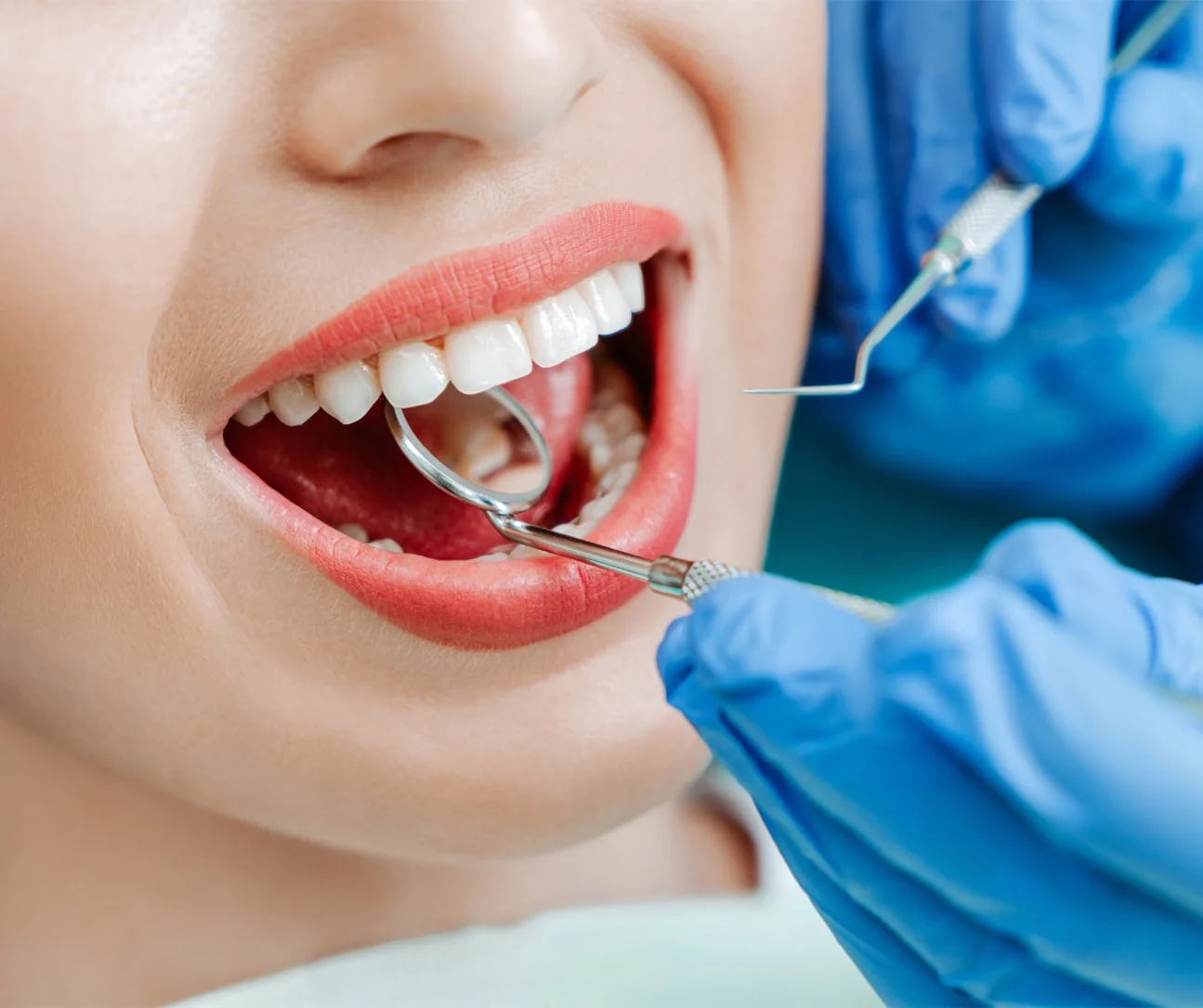

Home/Procedures & Treatments/Dental Implants/Bone Grafting and Regeneration
Bone grafting and other augmentation techniques, such as the sinus lift and ridge augmentation, can be very beneficial for patients experiencing both cosmetic and functional periodontal issues. Since bone is the foundation of your oral structures, a deficiency can lead to loose teeth or potential aesthetic concerns. This lack of adequate bone density can be caused by such factors as trauma gum disease). If the bone support gradually depletes, you may eventually need a tooth extraction.
Our board-certified periodontist, Dr. Daniel Lauer, is proficient at placing bone grafts to help restore the shape and integrity of patients’ oral structures. The procedure can be highly beneficial for those who have lost teeth, as well as those who need better support in order to secure their teeth.
 Before
Before After
AfterBone grafting is a technique that can actually regenerate lost bone, providing more solid support for your teeth. This can help you protect the function and appearance of your natural teeth, as well as improve your jawbone quality for potential dental implants in the future.
There are a number of advantages to bone grafting therapy, as it can address structural damage while preventing further problems from occurring. The procedure typically offers patients the following benefits:

The ideal candidates for bone grafting are those in overall good health who exhibit the need for increased bone volume. It is also important for these individuals to not have any medical conditions that could potentially interfere with the healing process after their surgery. Once you are determined to be a good candidate for bone grafting, Dr. Lauer will begin the procedure by first cleaning and disinfecting the gums.

Once your gum tissue has been sterilized, Dr. Lauer is able to surgically graft small pieces of donor bone material to the existing bone around the roots of your teeth. Over time, these grafts should fuse to your natural bone and strengthen the foundation of your teeth. By rebuilding these areas of bone recession, the health and appearance of your gums should improve as well. To help ease any dental fear or anxiety, our practice offers several types of sedation dentistry to help patients relax during the procedures.
Bone grafting can also be a useful technique in some dental implant procedures. For patients who do not have adequate bone density to accommodate an implant, there are cases in which a bone graft treatment can be performed to add extra volume to the jawbone and increase the chance for successful (and permanent) implant results.
Dr. Lauer specializes in the structures surrounding the teeth and how best to rebuild them should they recede with time. For those interested in dental implants to replace their missing teeth, he may recommend they first undergo bone grafting to establish a stronger, denser jawbone to support the titanium implant posts. This is often necessary to ensure implants properly fuse with the jawbone for a long-lasting, stable teeth replacement.
Bone grafting can address a variety of jawbone deficiencies — whether this is to prepare for implants or to simply preserve the jawbone structure. It is also commonly used in ridge augmentation and sinus lift procedures.
Patients typically recover well after a bone grafting procedure with prescribed antibiotics and anti-inflammatory medication to ensure a safe, smooth healing process. Common side effects include swelling, bruising, and discomfort around the incision site(s) but symptoms are usually well-managed with over-the-counter medication and ice packs. Prescription pain medication is rarely needed. Dr. Lauer understands that each patient feels discomfort differently and has an individual rate of healing; therefore, every patient will be assessed on a personal basis and assisted by their unique needs.
Most patients are able to return to work one to two days after the procedure, or after the sedation has completely worn off. Follow-up appointments are typically scheduled seven to 10 days after the procedure to check on the recovery progress. Patients are advised to avoid touching the grafted areas or stitches with anything (including their tongue), avoid hard or crunchy foods as well as any tobacco products and alcohol, and keep their head elevated to reduce swelling.
When bone grafting is done in preparation for dental implants, it may be possible to perform bone grafting and the implant placement in the same surgery if only minor grafting is necessary. For more advanced cases, the affected area may need several months to mature so the bone may fully heal and grow. Depending on the patient, this may take up to four to six months before the dental implants can be placed following a bone grafting procedure.

At Precision Periodontics & Implant Dentistry, a bone grafting procedure can range between $800 to $2,000 depending on a variety of factors, as each patient has different needs. Our team will evaluate the amount of bone loss, volume of bone grafting needed, and whether a dental implant will be placed—in which case we will need to assess how long the tooth has been missing, the size, and the reason the tooth needs to be removed or replaced.
After an examination and consultation, we will provide a detailed estimate of costs, discuss payment options, and review any questions you may have so you can make a well-informed decision for your dental care.
Some patients who are considering permanent dental implants to replace missing teeth may need an additional procedure, such as ridge augmentation or a sinus lift, to maximize the potential for successful results
Ridge augmentation can help patients who have experienced jawbone recession after tooth loss. Patients who have had dental implants placed in areas of missing teeth sometimes experience an indented appearance along the gums and jawbone where the implants reside. This indentation can cause an unnatural appearance, and be very hard to clean during routine brushing and flossing.
Ridge augmentation with bone grafting and Emdogain™ — a revolutionary gel-based solution that can actually regenerate soft gum tissue and bone — can fill the indented areas caused by jawbone recession. The procedure can also be beneficial immediately following tooth extraction to help minimize this bone loss. With ridge augmentation, you can achieve a more balanced and symmetrical gum line around the dental implant.
The sinus lift, or sinus augmentation, is a technique that can help you develop an adequate amount of bone in your upper back jaw to effectively anchor a dental implant. It is very common to have inadequate levels of bone in the upper back jaw, often due to tooth loss or gum disease. Since a dental implant is designed to fuse itself to the jawbone and become a part of your mouth like a natural tooth, it is important that the bone is strong enough to support it.
The sinus lift procedure essentially involves elevating a small piece of the existing bone into the sinus cavity and filling the space underneath it with a bone graft. This can allow for a more solid structural support for the implant, and a better chance for the implant to fuse precisely and successfully to the bone.
In the past, patients who did not have an adequate amount of jawbone density in the upper back part of the mouth were often deemed poor candidates for dental implants, since strong bone density is necessary to accommodate the implant. However, the sinus lift has changed that for many patients, allowing Dr. Lauer to add sufficient bone and gum tissue for the best possible dental implant results.
Sinus augmentation is not necessary for every patient considering dental implants — only those who are lacking sufficient bone levels in the upper back jaw area may need the procedure. However, for those patients it can be essential to establishing a good base of support for dental implants and allowing them to enjoy the many benefits of permanent teeth replacement.
“Nothing but good things to say. Probably the best experience I’ve had in my life in any part of the medical field. Great communication, super friendly staff, clean modern decor and superb treatment with patient care as the priority.”
If you would like more information about bone grafting or other regenerative periodontal procedures, please contact Precision Periodontics & Implant Dentistry. We can also help you schedule a consultation with Dr. Lauer, during which you can receive more personalized details about the health of your jawbone and whether grafting or augmentation is the best option for your needs.